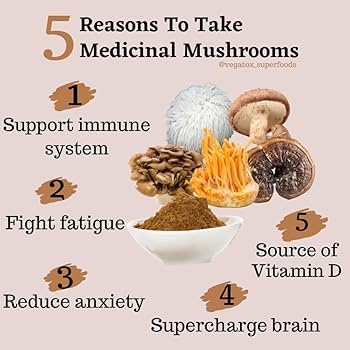
For centuries, mushrooms have been prized not only as food but as natural medicine. Modern research is confirming what traditional systems already knew: each mushroom species has a unique profile of compounds—beta-glucans, antioxidants, and other phytochemicals—that support different aspects of health. Here’s a guide to the most researched medical mushrooms, what they may help with, and how best to take them.
1. Shiitake (Lentinula edodes)
- Uses: Cardiovascular health, cholesterol balance, immune support.
- Research: Contains lentinan, shown to modulate immunity. Some studies suggest mild cholesterol-lowering effects.
- How to eat: Highly edible—great sautéed, grilled, or added to salads after light cooking.
2. Maitake (Grifola frondosa)
- Uses: Blood sugar regulation, immune system stimulation.
- Research: D-fraction extract studied for anti-tumor potential; also may improve insulin sensitivity.
- How to eat: Edible and tasty in stir-fries, soups, or as a salad topping when lightly cooked.
3. Reishi (Ganoderma lucidum)
- Uses: Stress adaptation, sleep support, immune balance.
- Research: Triterpenes and polysaccharides studied for anti-inflammatory, anti-cancer, and calming effects.
- How to take: Not typically eaten—woody and bitter. Best taken as capsule, powder, or tea extract.
4. Lion’s Mane (Hericium erinaceus)
- Uses: Cognitive health, nerve regeneration, mood support.
- Research: Compounds hericenones and erinacines stimulate nerve growth factor (NGF). Early studies suggest benefits in mild cognitive impairment.
- How to eat: Edible and delicious—resembles seafood when cooked. Can be pan-fried or added to soups and salads.
5. Turkey Tail (Trametes versicolor)
- Uses: Immune modulation, gut microbiome support.
- Research: Polysaccharopeptides (PSP, PSK) widely studied in cancer immunotherapy as adjuncts. Also show prebiotic activity.
- How to take: Too tough and woody for eating—best used as capsules, teas, or extracts.
6. Chaga (Inonotus obliquus)
- Uses: Antioxidant support, inflammation modulation.
- Research: Very high in polyphenols and melanin; studied for anti-inflammatory and antiviral effects.
- How to take: Hard fungal mass—not eaten whole. Best consumed as tea or capsules.
7. Cordyceps (Cordyceps militaris / C. sinensis)
- Uses: Energy, stamina, lung and kidney support.
- Research: Cordycepin and adenosine compounds studied for improved oxygen utilization and endurance.
- How to take: Not usually a food mushroom—best in capsule, tincture, or powder form.
8. Agaricus blazei
- Uses: Immune support, anti-tumor potential.
- Research: Beta-glucan–rich; used in Japan for adjunctive cancer care.
- How to eat: Can be eaten fresh but more commonly used in extracts or capsules for medicinal strength.
How to Incorporate Medical Mushrooms
- Dietary mushrooms (salads and meals): Shiitake, maitake, lion’s mane, and to a degree agaricus blazei are tasty, versatile, and provide health benefits in food form.
- Capsules / extracts (bitter or woody): Reishi, turkey tail, chaga, and cordyceps are rarely eaten directly; concentrated extracts are the practical way to use them medicinally.
- Combination formulas: Many supplements blend multiple mushroom extracts to provide a broad immune and adaptogenic effect.
Conclusion
Mushrooms are not all alike. Some, like shiitake or maitake, can go straight into your stir-fry or salad bowl. Others, like reishi or turkey tail, are better taken in capsules or tea. Each has its own “specialty”—from brain health to immune support, from cholesterol to energy. Understanding their unique profiles allows you to use them wisely, whether in the kitchen or in supplement form.

